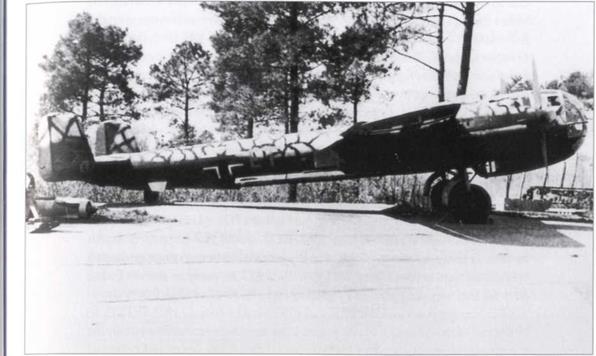Reorganisation of Luftwaffe Armaments
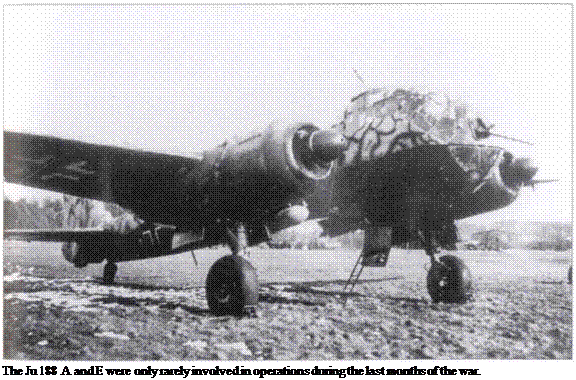
There was only one way to counter the comprehensive aerial strength of the enemy because of the limited possibilities of production in Germany. Tactical superiority was to be regained by high performance aircraft – ‘quality instead of quantity’. Faced with shortages of materials and no chance of a major increase in production, the fighter squadrons were to receive more efficient machines to clear the skies over the Reich of Allied P-47s and P-51s and their four-engined bombers. Time was the problem. It was impossible within a few weeks and
months to design, turn out and make operational a stream of new aircraft. The later experience with the He 162 Volksjager would prove the point.
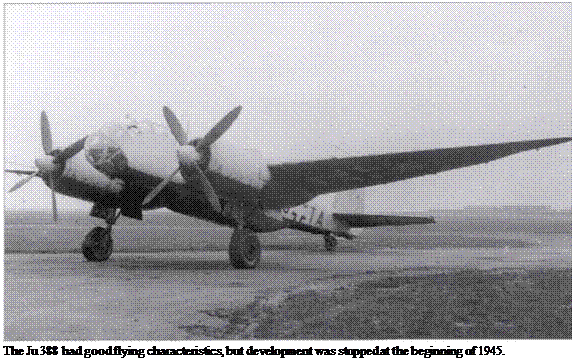 |
Even initial production of flak rockets was not completed, as long planned, by mid-1944, nor air-to-air rockets and weapons such as the futuristic revolver – cannon MG 213. In August 1944 OKL (Luftwaffe High Command) announced the future equipment of Luftwaffe squadrons for the period to December 1945. The nine and one-third bomber Geschwader in late summer 1944, most equipped with the Ju 88 and Ju 188, would be cut to eight, and in all probability two more would be disbanded during 1945 so that by the end of 1945 only six Geschwader would survive, equipped with the Ju 388 K-l. All Do 217-equipped units were to be disbanded by October 1944 at the latest. Ju 388 K-ls would replace the Ju 88 A-17s at KG 26. Between December 1944 and May 1945 three Gruppen of that unit were meant to get improved Ju 188s and Ju 388s for torpedo-bomber operations over the North Sea and Arctic waters. The fourth Gruppe would probably not come to operational strength because of the production situation at September 1944. The Gruppen to be disbanded were those flying the He 177 A-5 with remote control installations and the Do 217 K-3 with the Hs 293 A Kehl missile guidance system. As it could not be determined to what extent these aircraft would be required for missions in future,
[‘
|
Few operations were flown with the Do 217 M towards the wars end. Allied air superiority forced them into the night reconnaissance role. |
all 135 bombers would go provisionally into the OKL Reserve. A number of these were decommissioned on airfields in Denmark and Norway after the heavy losses suffered over Normandy and western France, some being cannibalised for their DB-605 engines for re-use in new machines. There would also be no further Fw 200 C units operating.
The further reduction of He 111 front-line groups would depend on demand: since the production of the He 111 H had been discontinued, the only fresh aircraft being delivered to units would arrive from the repair shops. III./KG 3 would receive ten aircraft monthly in connection with the V-l flying bomb programme. If and how the He 111 H-20s with other bomber groups would be operational on the Eastern Front was left open.
OKL wanted the Me 262 A-la/bo or A-2 available in two bomber Geschwader. From December 1944 a third Geschwader would be formed, and this strength would be maintained. The Me 262 Blitzbomber would be reduced to two Gruppen at the latest by March 1945 since KG 76 was being expanded into the first jet bomber Geschwader. III./KG 76 was planned as the first operational Gruppe with the Ar 234 C-3 or C-5. The first Do 335 bomber Gruppe was expected to be ready in July 1945: the Luftwaffe planners believed
that this would be the first, and probably only bomber unit to have this aircraft before the year was out. The Ju 287 was to be the first heavy jet bomber with the Luftwaffe. The first Gruppe was expected to be ready from July 1945, the second to follow at the year’s end by the latest. Although up to 20 per cent shortages due to delivery problems had been allowed for, it would have needed a great effort to meet these estimates by the scheduled dates, not least because some Ju 88 S-3s, Ju 388 K-ls, Me 262 A-ls and Do 335 A-ls were needed as training machines.
The dismantling and partial re-equipping of the bomber squadrons would continue to the end of 1945. Two Gruppen of LG 1 would receive the Ju 388 K-l instead of Ju 88 A-4. KG 2 would be disbanded if the Do 335 A-l was not available short-term: 14./KG 3 would be disbanded by October 1944, the V-l- equipped III./KG 3 by September 1945 at the latest. The same went for KG 4, whose I. to III. Gruppen, mostly flying the He 111 H-20 and H-16, would cease to operate between April and June 1945. KG 6 would lose its Ju 88 S-3s and Ju 188s in favour of the Ju 388 K-l in stages from February 1945, remaining operational until at least December 1945, while KG 26 would receive the Ju 388 M-l for anti-torpedo operations replacing its Ju 88 A-17s and Ju 188 A-3s.
OKL wanted the remainder of KG 27 disbanded by January 1945 and KG 30 by the end of that year. KG 40 was to remain in reserve, where the former bomber groups would be converted to the Me 262 fighter. The operational period of KG 51 with the Blitzbomber would be short: by the end of 1945 the recently converted units would be disbanded and replaced by KG 76.
KG 53 equipped with He 111 H-ll, H-16 and H-22 would be dissolved in March 1945. It was intended to replace the Ju 88s of at least two Gruppen of KG 54 with the Me 262. KG 55 was to be disbanded by November 1945. I./KG 66 was the only Luftwaffe pathfinder unit and would remain in service, receiving the Ju 388 K-l from August 1945. II. and III./KG 76 would test the Ar 234 B-2 for its suitability as a fast bomber. KG 100 with its He 177 A-5s would remain intact although no immediate operations were on hand for its PC 1400 X or Hs 293 missiles. As the last test unit, mostly equipped with the He 111 H-20, TGr 30 was to remain operational into the summer of 1945 although nobody could decide what should happen subsequently.
On account of lack of fuel and new replacement machines, the transport units were required to keep gong with clapped-out original-issue machines or converted He 111 bombers. The surviving Gruppen ofTG 1 to TG 4, except IV./TG 1, which flew the He 111 H-l to H-5, were to keep the slower but more robust Ju 52/3m. IV./TG 4 would continue to fly heavy machines such as the four-engined Pi 188, Fw 200 and Ju 290 and the three-engined Ju 252 and Ju 352. For transport missions over the battle zones, such as supply drops to encircled troops, TGr 20 would be used with He 111 H-6s, H-16s and principally H-20s and H-22s.
Further changes were foreseen for 1946. From the end of 1945, the air offensive would be pursued using the Do 335 in four Gruppen at KG 2, while two Gruppen at KG 76 and 12 other Gruppen elsewhere would fly the Ar 234. It was hoped to fit out two Gruppen at LG 1 with the Ju 388 high-altitude bomber, and KG 6 would remain in commission with the Ju 388 beyond January 1946, as would pathfinder Gruppe I./KG 66. Three Gruppen of torpedo bombers were planned for KG 76.
From the summer of 1944, Jabos were only operational as sections of ZG 26 and ZG 76. Both could field a single Gruppe, I./ZG 26 and II./ZG 76. Since the production of the Me 410 had been cancelled in the interim, the only fresh arrivals were from the repairers. This state of affairs was not expected to continue beyond February 1945. To replace these Gruppen, at least eight Gruppen were to be equipped with the Do 335 by the end of 1945, provided this aircraft proved superior to the RAF Mosquito. It was believed that two Jabo Gruppen could be formed between August and the end of December 1945 using Ju 388 J-ls orJ-3s.
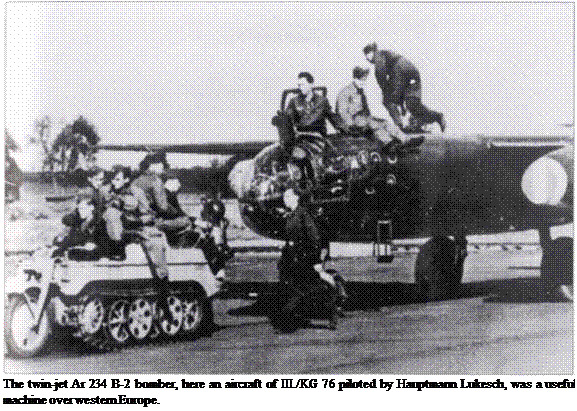 |
In the later summer of 1944, 21 long-range reconnaissance Staffeln were operational flying the Ju 88 D or Ju 188 F. Another three flights had the Me 410.
For night reconnaissance Aufklarungsgruppe Nacht had three StafFeln. 1. and 2. Staffel of Fernaufklarungsgruppe 5 flew maritime reconnaissance sorties, Aufklarungsgruppe 123 had two StafFeln equipped with Bf 109s. The majority of these units, 29 in all, were to be retained and would fly operations by day, 3 using the Ar 234 B-l, 14 the Do 335 A-4 and 10 the Ju 388 L-l. Ju 388 L-ls or L-3s would replace the Do 217s and Ju 188s of night reconnaissance units. A total of eight StafFeln of Ju 88 G-ls and G-6s would fly weather reporting, amongst them Wekusta OKL 1. He 177s of Wekusta OKL 2 flew long range reconnaissance. Later consideration was given to using the Ju 635 or perhaps the Hii 211.
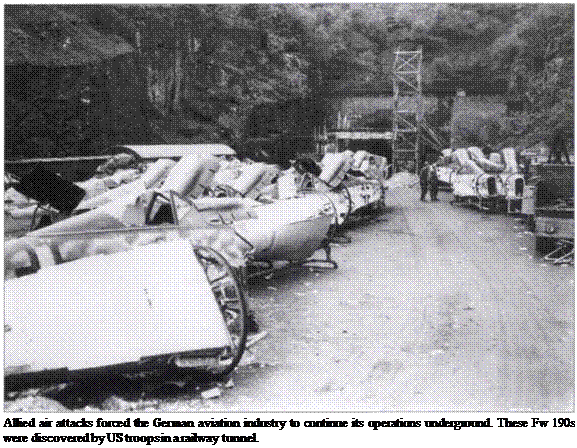 |
The extent to which these extremely optimistic plans were called into question by the end of 1944 is demonstrated by the idea of operating KG 51 (Me 262 A-la/A-2) and the Ar 234 B-2 at KG 76. Even after all Ju 388 production had been abandoned in favour of the jets, and the Do 335 and Ju 287 were put on hold, neither of the ambitious schemes for KG 51 and KG 76 ever came to fruition, not even partially.
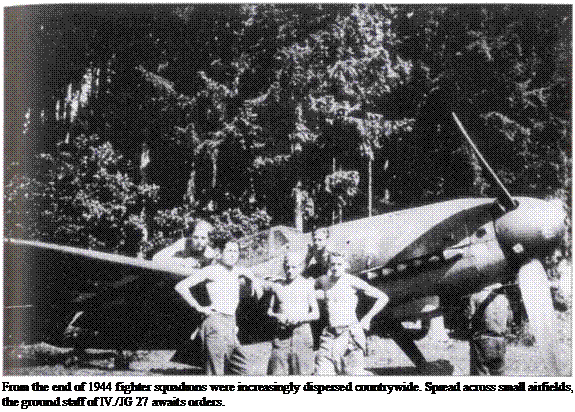
Once the rearrangement of the bomber formations was given up as impossible, the fighter and Jabo units were given absolute priority. Since small piston-engined aircraft and jets were easier to manufacture, the schedule was drawn up for large numbers by the end of 1944. It was clear to the squadrons that the Fw 190 D-9 or the Bf 109 K-4 together with the Me 262 jet fighter, coming off the lines in ever greater numbers, were the likely new deliveries. JG 1 wanted to exchange its Fw 190 A-8s and Bf 109 G-lOs for the Fw 190 A-9. JG 2 also required a complete changeover to the Fw 190 D-9. At JG 3 to JG 6, JG 11, JG 26, JG 27, JG 51 to JG 54 and JG 77, the existing Bf 109 G-6s, G-lOs and G-14s were to be exchanged for G-lOs and G-14s and principally K-4s. These machines would be delivered to squadrons from the beginning of 1945 to replace the Bf 109 G-6. All units flying the Fw 190 A-8 would make a gradual change to the A-9 and then D-9. Only a few units, in particular the three Gruppen of JG 26, were chosen to receive the Fw 190 D-12 instead of the A-9 or D-9 from the beginning of 1945.
All-weather units JG 300 and JG 301 had a special role. It was considered that the Fw 190 AS-6 to A-8 and Bf 109 G-6 to G-10/R6 of JG 300 should be
traded in for the Fw 190 A-6 to A-8 with A-9/R11 and then the Fw 190 D-9/R11. Later III./JG 301 would receive the Та 152.
The only rocket-fighter Geschwader, JG 400, would continue to use the Me 163, and perhaps later the Me 263 (Ju 248). The only jet-fighter Geschwader, JG 7, would retain the Me 262 A-la. All bomber Geschwader operating in the fighter role would receive the Bf 109 G-10 to K-4 or, to a lesser extent, the Fw 190 A-9/R11, while all units awaited delivery of the Me 262.
Jabo formations were to be equipped with the Fw 190 F-8 and F-9 to await mass production of the Та 152 when it was intended that many of these machines would be fitted to carry the Panzerblitz I to III or the Panzerschreck, both efficient anti-tank rockets. The Та 152 would have been an outstanding ground-attack aircraft with its more powerful engine. However, mass production had not begun by the end of 1944. For the moment a few units with Hs 129 B-3s and Ju 87 D-5s still flew missions mosdy over the Eastern Front.
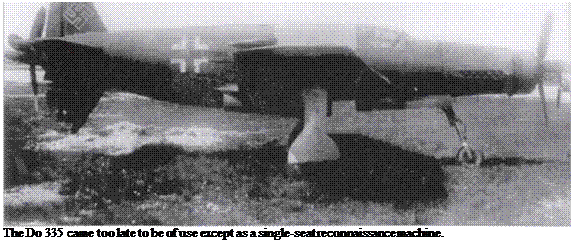 |
The night Jabo Gruppen NSGr I to X flew mainly the Ju 87 D-3 and D-5 until the end of 1944 except 4./NSGr II, NSGr V, and NSGr VII equipped with the Fiat CR 42. Most of these units also operated Ar 66 Cs and Ds, Go 145s, Fw 58s and Si 204 training aircraft converted to auxiliary night Jabos. All of these units flew initially with what was available. There is no indication of advance planning.
The seaworthy Do 24T-1 flying boat dominated amongst the few remaining air-sea rescue units. For aerial protection and search missions some Ju 88 C-4s and C-7s, Fw 190 A-8s and Jabos such as the Me 410 were on hand. No forward plans are known of, and are hardly to be expected in the light of the situation in 1945. In mid-December 1944 the general outlook was such that the intentions might still be forced through, though with delays. Once the Western Allies were advancing to the Rhine, and the Russians had begun their major offensive from Poland, the final collapse, perhaps within months, would become apparent.
From February 1945 – at steadily decreasing intervals – one emergency plan after another replaced the former policy. At the beginning of the year, the At 234, Do 335, He 162 and Me 262 were in the frame. Then the Do 335 was dropped. On 27 March 1945 Hitler put SS-Obergruppenfiihrer Kammler in charge of the development, testing and completion of all jet aircraft. As ‘General Plenipotentiary for Jet Aircraft’ in April 1945 he ordered that the Me 262 alone was to be produced in the greatest numbers possible. In that decision he saw the one last chance, and a small one, of providing a local air defence. It was a vain hope, for the war had long been lost.











